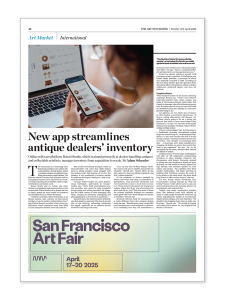Published in The Art Newspaper, April 2025.
Online software platform Ronati Studio, which is aimed primarily at dealers handling antiques and collectable artefacts, manages inventory from acquisition to resale. By Adam Schrader
 The commercial art technology firm Ronati has unveiled a new online software platform, Ronati Studio, aimed at antiques dealers and galleries handling pre-owned art and artefacts. The software claims to be the first all-in-one tool for managing inventory from acquisition to resale, covering everything from baseball cards to high-end furniture and historic work.
The commercial art technology firm Ronati has unveiled a new online software platform, Ronati Studio, aimed at antiques dealers and galleries handling pre-owned art and artefacts. The software claims to be the first all-in-one tool for managing inventory from acquisition to resale, covering everything from baseball cards to high-end furniture and historic work.
Ronati Studio and its mobile app allow dealers to photograph and document items with various data. These details can be shared via text or email, posted on social media or formatted into branded PDF tear sheets for buyers.
“A dealer could buy a piece of furniture at an Illinois auction, take a picture on their phone and have it on the market within half an hour,” says Clinton Howell, president of the Cinoa confederation, which represents more than 5,000 art and antiquities dealers across 20 countries.
Toby Lorford of Lorfords Antiques, based in Gloucestershire, UK, notes that while dealers excel at selling antiques, many struggle with the business side. And because of its size, the industry is not considered a lucrative market for software developers, leading to a lack of tailored solutions.
“Vintage dealers largely are quite dysfunctional individuals, particularly in Europe,” Lorford says. “We’re fairly unemployable creative weirdos who make the most wonderful living buying and selling beautiful old things. But the whole notion of then managing that stock, creating an inventory, cataloguing and photographing it is all a bit of a minefield.”
Stacey Tiveron, the chief executive of Ronati, says that despite a projected 15% annual growth rate in the industry, technology innovation has lagged — especially for an industry already known for not being tech savvy.
“Let’s say you have 20 Hans Wegner chairs. You want to sell one on 1stDibs and another on Chairish,” Howell says. “Ronati offers all the data entries to keep everything organised, and that’s almost priceless.”
Of the hundreds of dealers surveyed by Ronati, most were still using a combination of spreadsheets, word processor documents and even handwritten notes to track their inventories. “If you research the options for vintage and antique sellers, you’ll get tons of matches, but when you dig in, you’ll find that most of them are systems originally designed for manufactured goods that have been tweaked to market to resellers,” Tiveron says.
Inventory software built for manufacturers is very different from what antiques dealers need, she says. “Manufacturers have a single SKU [stock keeping unit, a code assigned to a product in an inventory] that they can manufacture a thousand times; dealers have a thousand unique item SKUs,” she says. “That’s a completely different administrative and management process.”
Ronati has already registered around 1,200 customers using its products, including the new Ronati Studio platform, a prototype of which was originally launched in 2019. According to Tiveron, those dealers span the spectrum from old-school offline and trade fair sellers to larger, well-known multi-staff dealers and even art galleries.
Complex software
“This should be of interest for anyone collecting anything,” Howell says. “I don’t care if they’re collecting baseball cards, coins, stamps, you name it. My business doesn’t really relate that closely to someone who sells 18th-century porcelain. To make software to try to cover this wide of a buckshot across the industry is a very complicated thing to do.”
Art galleries are less likely than furniture or other dealers to use Ronati, Howell says. “If they’re selling 18th-century Old Masters, it’s unlikely they’re going to be on a selling site because that niche is even more refined than furniture is,” he says. “So, the value is for people dealing with multiples of things. Unless they’re selling multiple prints.”
Tiveron acknowledges that transitioning to a cloud-based inventory management system might be intimidating for “mom-and-pop shop” dealers, so her team handles the task of transitioning a dealer’s existing inventory system into its format. “The thought of centralising their data … is daunting, and a huge impediment to changing old habits, no matter how much they want to get organised,” she says. “So, we set everything up for them, whether their records are offline or online.”
dealers, so her team handles the task of transitioning a dealer’s existing inventory system into its format. “The thought of centralising their data … is daunting, and a huge impediment to changing old habits, no matter how much they want to get organised,” she says. “So, we set everything up for them, whether their records are offline or online.”
Looking ahead, Tiveron hopes marketplaces will offer an API (application programming interface) to allow seamless inventory synchronisation with Ronati. Currently, uploads to selling sites and tracking in Ronati are done manually. An API would let dealers upload listings directly, with real-time updates on availability and pricing. “I’m confident that these smaller marketplaces will begin investing in building their interfaces, because the easier it is for sellers to list their stock, the more stock they’ll have to offer to their buyers,” she says.
For now, Ronati Studio streamlines marketplace posting through its “Prep for Listing” feature, which allows users to copy and paste listing details easily, reducing reliance on spreadsheets and scattered files.
Lorford sees major marketplace implications. The software could help millions of items in small shops around the world end up online, expanding the market as eco-conscious buyers favour antiques over new furniture. “We shouldn’t be chopping down trees to make new furniture,” Howell says. “We should be buying and selling old furniture. So, I’m delighted that Ronati is out there.”
_____________________________________________________________________________________________________________
For press inquiries please contact press@ronati.com.
Learn more about Ronati Studio.




